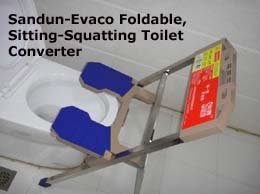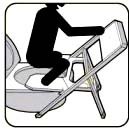|
Childbirth - The Long Forgotten, Ideal Position
This Childbirth section builds upon the Pregnancy section which highlights the need for pregnant women to squat instead of sit for waste elimination. It explains why squatting is also most advantageous position for childbirth, and provides an insight on the grave impact of sitting toilets and modern birthing practices on women's health. The Western toilet is not the brilliant modern invention that many believe it to be. It is a health hazard. This porcelain throne has not only prevented women from adopting the best posture for waste evacuation (squatting), but also rendered them incapable of using the same ideal posture for childbirth. Before hospitalized births, women have always given birth using the position that she finds most natural and comfortable. For most women, it was
squatting.
Modern Birthing Positions Are Ergonomic Nightmares for Both Mother and Baby… Up to the late 1960's, the standard position for childbirth was the lithotomy position, where the mother lie flat on her back with her feet tied to and held up by stirrups. The lithotomy position was an ergonomic nightmare for both mother and baby. No other position could be worse than this position for childbirth. It was said that the lithotomy position originated from a command by French king Louis XIV, who wanted to see one of his mistresses giving birth. Women hated this position because they could not exercise any control over the birth of their baby. On her back and with her legs up in the air, she cannot move much. The pressure of the baby’s head on her back and tailbone can be very painful. Also the poor mother has to push her baby 'uphill' against the force of gravity. This requires her to strain and push harder and longer. Additionally, in this position, the size of her birth canal can be reduced by up to 30%. As a result, during delivery, the baby is used as a "wedge" to force open the narrowed birth canal. This causes great pain and distress for the mother, and prolongs her labor. Despite valiant efforts, many women - with the laws of physics and biology stacked against them - become exhausted and could not give birth easily.
The semi-sitting position has virtually replaced the lithotomy position. Although it lessens some negative aspects of the lithotomy position, the semi-sitting position is not good enough… The truth is that the lithotomy and semi-sitting positions were not developed with the mother and baby in mind, but to cater to those who attend to her. These two positions are ideal for the doctor to have a good view, help with delivery of the baby and to intervene when it is necessary.
Just as sitting toilets force users to strain while holding the breath for evacuation (Valsalva Maneuver), a woman lying flat on her back or in a semi-sitting position has to do the same... She has to hold her breath and strain and push with all her might -- unaware that the birth canal is not fully opened. This puts an enormous strain on the pelvic floor, which can result in a pelvic floor prolapse, which in turn can result in stretch injury of the pudendal nerve, which runs through the pelvic floor. The pudendal nerve is responsible for bladder and sexual functions. An injured or damaged pudendal nerve injury can cause urinary and fecal incontinence and other pelvic problems.
Often, obstetricians who are not aware of the underlying cause of the lack of progress in labor often resort to drugs and elaborate procedures (vacuum extractors, forceps, epidurals and episiotomies) to "help" the baby come along. Their crude and forceful interventions increase the risk of injury to mother and baby. The most terrible form of medical intervention is the Caesarean section (C-section). Fearful -- and not knowing the exact cause -- of long and painful vaginal births, many women are opting for C-sections. According to the World Health Organization, no country is justified in having a caesarean rate of more than 10 to 15%. Yet, in the United States, the rate far exceeds this guideline... more than 25% of babies (one in four babies) are now delivered by C-sections.
SIDENOTE In many cases, however, C-sections are done for convenience or because of a decision to have pain-free labor. This is unfortunate because there are many benefits of a natural birth. C-sections also create many risks for both mother and baby.
Squatting -- The Most Ideal Position for Childbirth
In the developing world where squatting is the norm, women deliver with greater ease. For them, squatting on floors is natural to them. Hence they have easier childbirths and are relatively unaffected by pelvic floor problems. The squatting posture aligns the pelvis and fully opens up the birth canal. In this position, a pregnant woman does not need the Valsalva Maneuver which would exert pressure on her pelvic floor. Also the effect of gravity is maximized to make pushing easy and also help the baby come down the birth canal. Conclusion Becoming pregnant and childbirth should be a joyful and exciting experience for every woman. Sadly, most hospitals and obstetricians -- by prohibiting or discouraging the ideal childbirthing posture -- stand in the way. You can do something about it. Learn all you can from others who have the passion, knowledge and resources to help you to give birth in the way intended by Nature. For a start, I recommend Ms Connie Banack, Founder of Mother Care.
To regain the ability to squat, you need to consciously practise squatting as you go about your daily activities, eg: picking up things from the floor, talking with young children etc. (You can watch videos on squatting exercises in the Pregnancy Section.) What You Can Do If you wish to do prepare better for childbirth by changing your toileting posture from sitting to squatting, consider getting a toilet squatting platform or converter.

Finally, you might want to find out what Gurmukh Kaur Khalsa, the internationally renowned yoga, pre-natal and post-natal care teacher has to say about squatting and preparing for childbirth on this page.
Have A Great Story About This Topic?Do you have a personal account about the topic discussed on this page? Please consider sharing it. You can be sure that many people in the world would love to read about and greatly benefit from your experience. It's easy to do. Just let your words flow. Thanks for sharing! What Other Visitors Have SaidClick below to see contributions from other visitors to this page...
So true Not rated yet
Squatting and Childbirth Not rated yet |
The Best Toilet Converter in The World Today!


Helping People All Over
The World Achieve
Good Health Through
Correct Toileting Posture
Watch video on the
origin and story of
the Sandun-Evaco
toilet converter
All about Life,
Hope and Truth...
FREE:
One of the most
astounding books
you will ever read
in your life!









